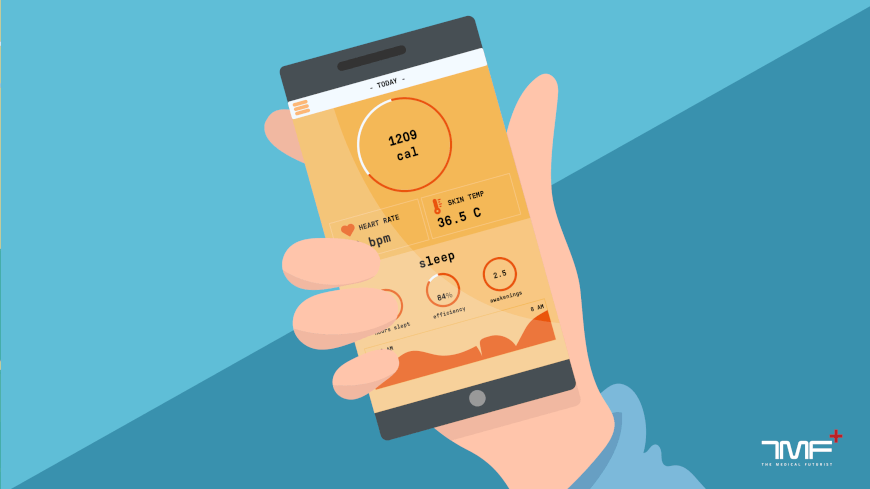The appearance of user-generated big data in healthcare

In the last couple of years, Fitbit, Misfit, Jawbone, Apple Health, Sleep as Android, WIWE, MocaCare, Skeeper – in other words, fitness trackers, step counters, health apps, sleep sensors, pocket ECG, blood pressure or other health parameter measuring devices appeared out of nowhere. By now, they constitute significant players on the health, wellness and fitness market; generating an astounding amount of data about patients and individuals not getting patient care. That’s what digital biomarkers are about.
According to Markets and Markets, the global market for medical wearable devices is projected to reach $12.1 billion by 2021, with the US being the largest market. RockHealth’s report outlines the dynamic development of the health app market in the United States and estimates that its turnover could increase from $10 to $31 billion. Moreover, health and fitness technology was projected to be as high as 274 million devices in 2016 globally.
The exponential rise in data-generating devices naturally goes together with the growth of healthcare data at an astronomical rate. According to a Stanford Medicine White Paper, 153 exabytes (one exabyte = one billion gigabytes) were produced in 2013, and an estimated 2,314 exabytes will be generated in 2020, translating to an overall rate of increase at least 48 percent annually. That data includes information from electronic medical records (medical imaging, patient history, etc.), genetic as well as patient-generated data. Even if looking only at the latter, the digital biomarkers themselves, that means an inconceivable amount of new information in the healthcare scene.

Digital biomarkers decoded
From the above statistics, the boundaries of digital biomarkers could also be determined. X-ray or the results of a DNA test don’t belong to the area of digital biomarkers. On the other hand, Fitbit or Misfit data does, so not only medical-grade information constitutes the huge chunk of digital biomarkers, but also fitness and wellness data. The third important factor is the digital nature of data collection, so although a traditional blood test could result in insightful biomarkers, meaning objectively measured and evaluated indicators of normal biological processes, pathogenic processes, or pharmacologic responses to a therapeutic intervention, they are not part of the digital universe.
Thus, the definition could be laid down as the following: digital biomarkers are data that consumers directly collect about health or disease management through digital health technologies to explain, influence and/or predict health-related outcomes.
RockHealth says that measured data only becomes a biomarker when it connects to a health-related outcome. If the blood pressure values are linked to cardiovascular risks, for example. That’s the point where it gets interesting for research.

The application of digital biomarkers
When paired with analytical tools, these large volumes of data can be leveraged to track trends and patterns for both individuals and populations. Medical research has already recognized the tremendous potential in digital biomarkers, and there are plenty of studies underway to understand disease and health better.
For example, in February 2018, Evidation Health announced the launch of a 10,000 person chronic pain study. The research aims to quantify chronic pain and develop digital biomarkers for chronic pain severity, flare-ups and quality of life by using activity trackers, health apps, and other more traditional data points. In the year-long study, participants will use Apple Watches, Garmins, and Android Watches.
However, researchers started to look at elderly adults with dementia, patients with Parkinson’s or Huntington’s through wearables, accelerometers, smartwatches, etc. Even the effect of digital pills was measured in a 2017 study, and it turned out that digital medicines indeed constitute efficient means to track medication intake.

What does the (near) future bring?
Digital biomarkers could significantly help in bringing healthcare from a reactive towards a more preventive approach, as researchers will not only be able to explain diseases better, but more and more data will be available to analyze what healthy, normal states signify and to predict future health outcomes. As a consequence, research into digital biomarkers will soar in the coming years. Roche already has an entire division and open positions dedicated to the topic.
However, there are several challenges to overcome in the near future.
- Standardized solutions are needed to be able to compare studies carried out with digital biomarkers. When a clinical trial is conducted, the standardized procedure makes sure sampling means the same in every case, and thus results are comparable with other achievements. Regarding consumer-generated data, that’s not that evident. The framework in the case of measurements carried out with smartwatches or trackers could be completely different in each situation.
- The reliability of some instruments is also questionable as not every wearable or health sensor is FDA- or CE-approved.
- The details of the measurements could also be entirely different. An individual could measure ECG at home with five different tools. While the results will (should) be reasonably similar, the quality and details of the measurements differ significantly, which might be essential for the researcher.
- Privacy and more generally, regulatory issues also constitute a matter of concern. While the consumer or patient measures digital biomarkers at home and sends the data to the researchers, how could anyone make sure that it gets to unauthorized persons? How will data protection and privacy look?
